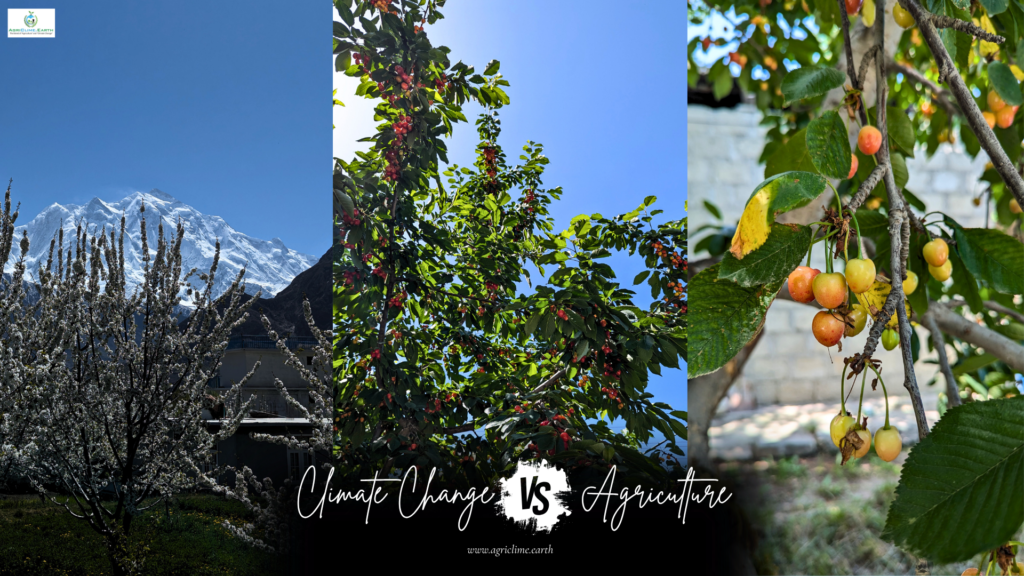
Gilgit-Baltistan, known as Pakistan’s mountainous crown jewel, is home to over 50 varieties of high-quality temperate fruits including cherries, apricots, apples, grapes, mulberries, and pomegranates. Its unique high-altitude climate and fertile valleys make it an ideal zone for orchard farming. These fruits not only supply domestic markets across Pakistan but are also exported internationally contributing to both the region’s and the country’s agricultural economy. But this once stable system is now under serious threat. Over the past decade, the escalating impacts of climate change have disrupted the agricultural cycles in Gilgit-Baltistan particularly its fruit farming sector.
Rising Temperatures & Shifting Seasons.
Climate change is reshaping weather patterns in this fragile mountain ecosystem. In recent years, early springs, dry winters, reduced snowfall, and unexpected extreme weather events have been reported across GB. Farmers now face erratic seasonal transitions that no longer align with traditional growing calendars.
In the Nagar district, one of the key fruit-producing areas, 87.7% of farmers surveyed have reported negative climate impacts on their crops. These include:
- Increased pest and disease outbreaks
- Decreased water availability for irrigation
- Disruption of bloom cycles
- Lower fruit quality and overall yields
What once was predictable is now uncertain.
When Blossoms Are Buried in Snow.
One of the most devastating effects has been the impact on fruit blossoms a crucial pre-harvest stage.
In April 2025, unexpected snowfall during peak flowering devastated cherry and apricot orchards across multiple districts. This isn’t an isolated case. Sudden hailstorms, wind, and off-season rainfall have become more frequent in recent years, particularly during blossom and fruiting stages. Such weather damages the fragile flowers, reduces fruit set, and in many cases, leads to total crop failure wiping out a year’s worth of labor and income.
The Threat to Irrigation Systems.
Glaciers in the Karakoram and Himalaya ranges feed the streams and irrigation channels that sustain agriculture in Gilgit-Baltistan. But with glacial retreat accelerating, the region now faces:
- Glacial lake outburst floods (GLOFs).
- Rapid snowmelt.
- Flash floods that destroy irrigation infrastructure.
These climate-induced hazards not only wash away orchards but also damage channels vital to water delivery for months. On average, it takes 4 to 6 months to rebuild destroyed systems leaving entire fruit-growing areas dry during the critical summer growing season. According to the WWF Pakistan, Gilgit-Baltistan is among the most climate-vulnerable areas in the country due to its reliance on glacier-fed agriculture and its exposure to temperature and precipitation changes.
Economic Impact on Farmers.
The consequences are more than agricultural they’re economic and social. As yields drop and pre-harvest losses rise:
- Farmers lose access to consistent income.
- Young workers migrate to cities for alternative jobs.
- Traditional farming knowledge and skills are at risk of being lost
.In many cases, families who have relied on fruit farming for generations are now being forced to diversify into other, often unstable, income sources — such as daily wage labor or tourism.
Long-Term Climate Trends in Gilgit-Baltistan.
Over the past 10 years, Gilgit-Baltistan has experienced a steady rise in average temperature. According to the Pakistan Meteorological Department, GB’s temperature is increasing faster than the national average, making it a hotspot for observing the effects of global warming.
These patterns include:
- Shorter and warmer winters.
- Erratic spring seasons.
- Unpredictable frost events.
- Frequent floods and landslides linked to intense precipitation.
This climate instability is not just affecting fruit farming, but also threatening food security, livelihoods, and the cultural heritage of mountain communities.
How Can This Be Addressed?
To adapt to the changing climate, urgent interventions are needed — from both the government and the community:
🔧 Local Adaptation Strategies.
- Installing climate-resilient irrigation systems (e.g., pipe-fed or solar-powered pumps).
- Introducing early warning systems for hail and frost.
- Training farmers in crop protection and post-harvest techniques.
📊 Government & Policy Support.
- Providing climate insurance schemes for fruit farmers.
- Investing in disaster-resilient rural infrastructure.
- Supporting research and development in adaptive horticulture.
Organizations like UNDP Pakistan are already piloting climate-resilient agriculture in vulnerable mountain regions, but these initiatives need to be scaled up.
Final Thoughts.
Gilgit-Baltistan’s fruit farming isn’t just about economics — it’s about identity, sustainability, and survival. These mountain communities have lived in harmony with nature for centuries. But now, with climate change accelerating, their resilience is being tested like never before.
If we want to preserve this region’s unique agricultural legacy, we must act now — by empowering local farmers, modernizing infrastructure, and integrating climate adaptation into national agricultural policies.

Pingback: Why Food Sovereignty & Food Security Debate Is Heating Up in 2025? - agriclime.earth